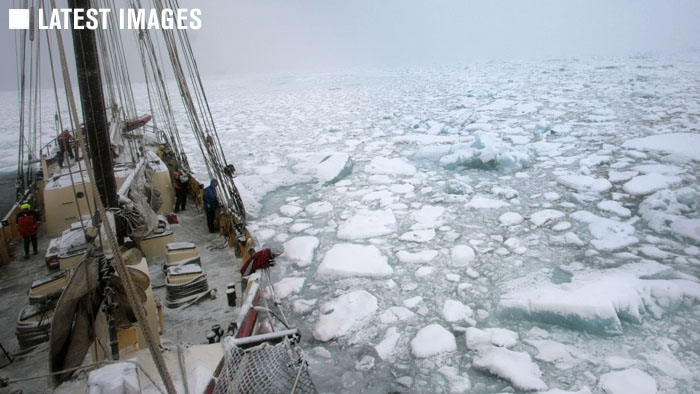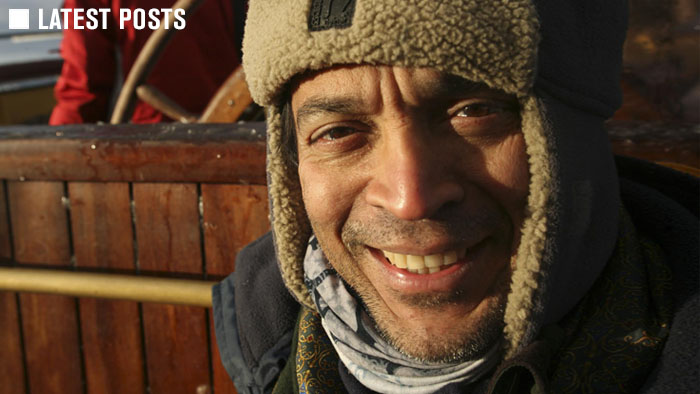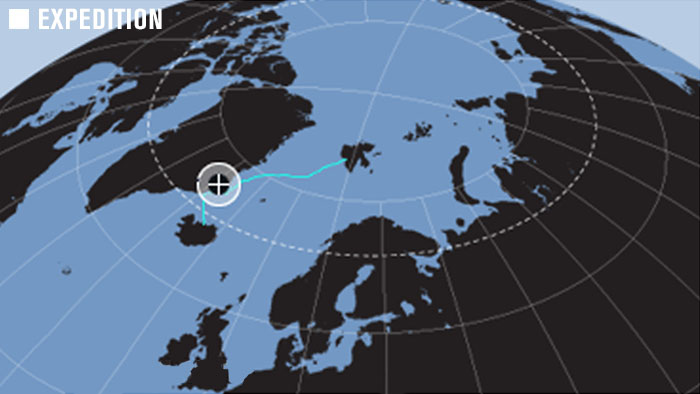About the voyage
Greenland Voyage
23 September – 10 October 2007
Longyearbyen, Svalbard – Greenland – Iceland
The Greenland Voyage – Cape Farewell’s fourth art and science voyage and its most ambitious expedition to date – attempted to sail across the 78th parallel to eastern Greenland, a passage only made possible due to the melting sea ice. Taking almost three weeks (23 September – 10 October), the expedition crossed the north Atlantic to the extreme frontline of climate change, then sailed south to explore East Greenland’s Blosseville Coast.
The expedition brought together writers Vikram Seth and Dallas Murphy, comedian Marcus Brigstocke, artists Amy Balkin, Kathy Barber, David Buckland, Beth Derbyshire, Dan Harvey, Vicky Long, Brian Jungen, Shiro Takatini, musicians Liam Frost and Aminatu Goumar, and journalist Ben Jervey. Dr Simon Boxall of the National Oceanography Centre, along with Dr Carol Cotterill and Emily Venables monitored the robustness of the Gulf Stream and a media team including acclaimed environmental photographer and filmmaker, Nick Cobbing, director Caroline Ross-Pirie and cameraman Matt Wainwright documented the expedition and the most recent impacts of climate change.
The voyage crossed the Greenland Sea from Longyearbyen, Svalbard on the 78th parallel to the East Coast of Greenland. Unable to enter Scoresby Sund due to sea ice, the schooner Noorderlicht sailed south to explore the coastal fjords of the Blosseville Coast before crossing the Denmark Straits to complete the voyage in Akureyi, Iceland.
The expedition is made in the spirit of a truly joint endeavor between the international arts and science communities. Seven nationalities are represented on board; the UK, US, Canada, India, Japan, Sahara and Australia. The team helped sail the schooner through the seas that hold the key to understanding changes in our weather patterns and climate.
What took place?
The Scientists
The scientists mapped temperature, salinity and flow patterns along the 78th parallel, using state of the art technology to determine the strength and changes in the West Spitsbergen Current, warm salty Atlantic Water, and the returning cold east Greenland Current. By making comparisons with previous years’ data they were able to determine how serious the issues of ice melt and current change are becoming. These are issues that will directly affect everyone in the North Atlantic region. As we tracked down the coast of Greenland they were also able to measure how much freshwater is flowing into our seas due to glacial melt, causing sea level rises globally. During the Greenland Sea crossing an Argo float was deployed from the Noorderlicht, which will continue to make measurements of flow and temperature, and relay data via satellite for the next three years.
The Artists
The artists worked alongside the scientists to learn about climate change and specifically about its impacts in the North Atlantic region. In response to the science and the Arctic environment, the art team created work, some pursuing projects already conceived such as Beth Derbyshire’s video work Anthem. Via the daily video reports, blogs, and images they were able to communicate their experiences back to the website and exhibitions at Southbank Centre and Eden Project.
Following the voyage, Cape Farewell will support the artists in creating work inspired by the voyage.
Want to know more?
Why Greenland? »
Meet the crew »
How can I get involved? »
Expedition partners and sponsors »



